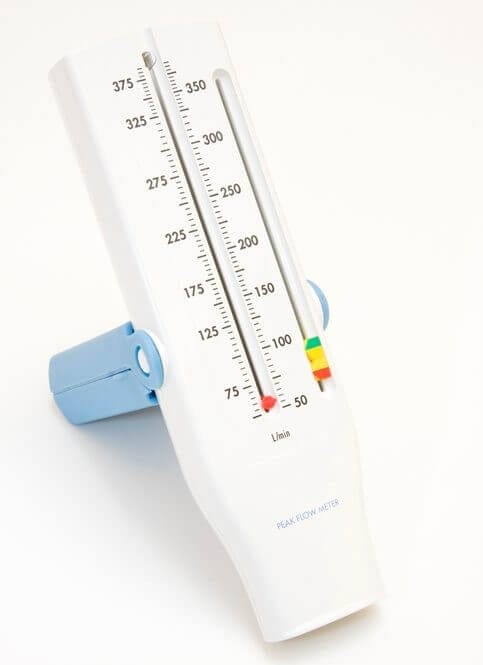
Asthma medications play an essential role in managing asthma – a chronic disease of the airways. If not well-controlled, asthma can produce symptoms such as chest tightness, difficulty breathing, coughing or wheezing. Poor control can even land you in the hospital.
As it’s important to know the treatment options, Allergic Living created the following guide to asthma medications and protocols.
Treatment to manage symptoms includes inhaled medicine, pills or injections. The severity of asthma differs greatly among patients, which is why there is a range of medication approaches.
“When determining if a patient needs a daily controller medication, such as inhaled corticosteroids, it is important to classify the severity of a patient’s asthma,” says Dr. William Anderson of Children’s Hospital Colorado. He is the director of the hospital’s Multidisciplinary Asthma Clinic.
Physicians will evaluate the frequency of a patient’s symptoms and exacerbations. Anderson, an associate professor of pediatric allergy at the University of Colorado School of Medicine, says this helps in determining whether they need a daily controller therapy.
The 2020 National Institutes of Health (NIH) asthma management guidelines recommend a stepwise approach to managing the chronic lung disease. The guidelines to assist healthcare providers divide patients into age categories: children (ages 0-4 and 5-11), and youth and adults 12 and older. The steps provide treatment advice for intermittent asthma (step 1) and persistent asthma, as asthma worsens, up to a step 6.
The NIH advises: “Consider the severity of an individual’s asthma, the small benefit, and the extent of previous symptoms and exacerbations when recommending allergen mitigation interventions.”
By taking a controller medication regularly, such as an inhaled corticosteroid (ICS), patients can keep the underlying inflammation in check. This means if they are exposed to a trigger, they are less likely to have symptoms.
Inhaled Corticosteroid Medication (ICS)
The NIH guidelines recommend that most patients with persistent asthma need an ICS controller inhaler daily. If you or your child needs an asthma controller medication, there’s a good chance the doctor will prescribe an inhaled corticosteroid.
However, in milder asthma, the guidelines say a physician may only advise to use the ICS alongside the reliever inhaler when symptoms arise. Some people with mild asthma do not need a controller medication at all.
Inhaled corticosteroids are most often taken through a device called a metered-dose inhaler. To use one, you press down on the inhaler and a dose of medication is delivered. Dry powder inhalers are also available.
ICS inhalers include: QVAR (beclamethasone dipropionate); authorized generic Flovent (fluticasone propionate); Pulmicort Flexhaler (budesonide); Arnuity Ellipta (fluticasone furoate); Alvesco (ciclesonide); Asmanex (mometasone furoate).
Bronchodilators or Relievers
These are the rescue medications in asthma. Often called the “reliever” inhaler, you’ll want to carry yours with you at all times. This is the puffer, which most commonly contains albuterol, that will open up your airways and improve your breathing if you’re feeling symptoms. Relievers, however, cannot control underlying inflammation, that’s the job of the controller inhaler.
Anderson outlines some common mistakes patients make when using bronchodilators. They include:
- Using the wrong technique or not using a spacer if a doctor advised to use one.
- Relying too much on the rescue inhaler. If you are using a bronchodilator for symptoms more than two days per week, “it indicates asthma is not well-controlled.”
- Using inhaled steroids only to treat asthma flare-ups. “These medications alone will not quickly relieve symptoms.”
Bronchodilators include: Ventolin (albuterol or salbutamol); generic terbutaline (formerly Bricanyl brand).
Long-Acting-Beta-Agonists (LABAs)
Rather than targeting inflammation, these inhalers open up the airways for up to 12 hours. They are taken twice a day, but are only prescribed if you’re also taking an inhaled corticosteroid.
Therapy using LABAs and ICS inhalers together should be considered as an initial treatment in moderate to severe asthma, Anderson says. As well, he notes that the combination is used as a step-up treatment when symptoms are not controlled on inhaled steroids alone.
LABAs include: Serevent Diskus (salmeterol); and Foradil (formoterol)
SMART (Single Maintenance and Reliever Therapy)
The newer SMART approach combines maintenance and rescue therapy into one metered-dose inhaler. The inhaler is designed for long-term control and quick relief for asthma exacerbations. It contains both a corticosteroid controller medication (budesonide or mometasone furoate) and a long-acting beta agonist (formoterol).

The 2020 NIH asthma management guidelines recommend SMART as a treatment option for patients ages 4 and older with moderate to severe persistent asthma. This is usually the recommended step-up for patients who are already taking a daily low-dose ICS, Anderson says.
“A benefit is convenience for patients, in that they just have to remember to use one inhaler for both their rescue and controller therapy,” he says.
Dr. Matthew Rank, professor of medicine at the Mayo Clinic in Phoenix, agrees it’s easier for patients to use one inhaler instead of two. The allergist-immunologist finds that linking anti-inflammatory medication with rescue treatment for worsening symptoms helps to reduce asthma flare-ups.
As well, Rank says patients sometimes confuse which inhaler is for which purpose or they’ll forget to bring one while traveling.
“However, the shift to using SMART also has challenges, including the dissemination of this new approach to the healthcare providers,” he notes. Education on how to use the combination inhaler is key for patients switching to SMART.
Patients who aren’t accurate observers of symptoms might have more difficulty with SMART, Rank says. For example, some under-treat exacerbations if they are not aware of escalating symptoms, or over-treat if they are anxious or misread symptoms. Rank cites as an example of the latter being out of breath during fitness, but not having breathing distress from asthma.
Once some of the barriers to this approach are overcome, Rank expects SMART to be the primary treatment choice in a few years.
SMART options include: Symbicort (budesonide / formoterol); and Dulera (mometasone furoate / formoterol).
SMART and Insurance Issues
Anderson says another barrier when considering SMART is insurance coverage, especially if the insurance company only covers one refill per month. Some patients who use SMART might need more than one inhaler per month because of using more doses or because they need one to keep at school, he says.
Rank has noticed some further challenges with insurance coverage. The SMART option might not be the preferred inhaler on an insurance company’s formulary, so the insurance might require patients to fail other ICS treatments before agreeing to cover it, Rank says.
If you are using a SMART approach and are under 12 years old, Anderson advises you should not take more than 8 puffs in a day (including inhalations from your daily controller). Patients older than 12, should take no more than 12 puffs per day (including the daily controller).
Other Combination Asthma Medications
Many people with tough-to-manage asthma gain control with inhalers that combine inhaled corticosteroids with a long-acting beta agonist (LABA). The approach helps to better open up a patient’s airways.
This type of combination is different than SMART therapy because of the medication used. The long-acting beta-agonist in the SMART medication is formoterol, which acts quickly, similar to albuterol. Anderson explains that salmeterol, another long-acting beta-agonist used in combined therapies, does not have quick onset of action. He says it should not be used for SMART.
Combination inhalers include: Airsupra (albuterol and budesonide); Advair HFA and Advair Diskus (fluticasone and salmeterol); AirDuo RespiClick (fluticasone and salmeterol); and Wixela Inhub (generic of Advair Diskus).
Anti-Leukotriene Receptor Antagonists (LTRAs)
Leukotrienes are signaling molecules that contribute to airway inflammation, which causes asthma symptoms. Anti-leukotriene receptor antagonists block that inflammation.
LTRAs are recommended as an alternative controller therapy to inhaled corticosteroids, Anderson says. This can be used either alone or in combination with other controller medications.
In 2020, the FDA issued a black box warning on Singulair and generic tablets, chewable tablets and oral granules. These all contain the active ingredient montelukast. The regulator cited evidence of serious mental health side effects in some patients taking the drug. Given the black box warning, Anderson recommends using inhaled steroids alone or ICS-LABA therapy before adding montelukast.
However, Singulair can be considered as an alternative if a patient is unable to take inhaled steroids or prefers oral asthma medication, he says. “I would make sure to discuss potential risks associated with Singulair prior to prescribing it,” Anderson says.
LTRAs include: Singulair (montelukast); Accolate (zafirlukast).
Biologic Asthma Options
Biologics are injectable drugs that target specific molecules that trigger airway inflammation in patients with asthma. Injections are given in a healthcare setting or at home, depending on a doctor’s recommendation and insurance requirements.
The six biologics with FDA approval for asthma target a type of airway inflammation called Type 2 inflammation, Rank explains. This swelling of the airways can lead to symptoms of cough, wheeze, shortness of breath, and/or chest tightness. The various biologics target different parts of this Type 2 pathway.
Biologic treatment is recommended for patients with moderate-to-severe asthma who face challenges with asthma control. For instance, those who have persistent symptoms or exacerbations, despite routine use of prescribed medication.
It is recommended that patients continue to use their daily maintenance inhalers while taking biologics, Rank says.
He recommends a four- to six-month trial period when starting a new biologic. While the medicine might start to work sooner, multiple factors and triggers must be considered. These contribute to asthma flares over time.
Before prescribing a biologic, Anderson says your doctor will likely do the following:
- Confirm proper medication technique and adherence.
- Evaluate for exposure to triggers and recommend how to mitigate those triggers.
- Evaluate for any conditions beyond asthma that could be contributing to symptoms.
- Evaluate for any psychosocial barriers that may contribute to symptoms or medication use.
Cost also plays a role in the decision to start a biologic. Rank says insurance companies have differing policies about these drugs. This means there could be back and forth between healthcare providers and insurance companies to see whether one will be covered.
He stresses having reasonable expectations when trying biologics, and to reassess after a trial period to see if goals are being met. For example, is the patient missing less school or work, or have they been able to decrease their use of oral steroid pills (prednisone)?
Rank has seen various outcomes for his patients at Mayo Clinic using biologics. While some patients don’t respond to the treatment, “having these therapies available has made a really big difference for those patients with severe asthma,” he says.
Biologics include: Xolair (omalizumab); Nucala (mepolizumab); Fasenra (benralizumab); Cinqair (reslizumab); Dupixent (dupilumab); and Tezspire (tezepelumab).
Taking Medication for Asthma
The variety of medications and inhalers can get confusing for patients. It is essential to talk to your healthcare provider about how and when to use your medications. They can provide information and demonstrations on proper use.
The NIH guidelines recommend inhaler technique be reviewed at every visit, Anderson says. Poor technique can be a reason inhaled medications are not working.
It is important to remember to take medication daily (or as prescribed), regardless of symptoms, Anderson notes. Patients who stop taking controller medication when they feel better, put themselves at risk of a return of symptoms and a flare-up. A doctor can help you decide if you should step down or stop your therapy if your asthma is well-controlled, he says.
Patients who continue to have asthma symptoms while taking controller therapy as prescribed, should talk to their doctor.
Asthma: Must-have Tools
Asthma Action Plan
The Asthma Action Plan is an essential tool that you can fill out with your doctor, and then refer to when you start having asthma symptoms. It shows you what medication you should be taking, and how to adjust your medication if symptoms worsen.
“Patients should always have access to their asthma action plan,” Anderson says. “Following an asthma action plan can help prevent symptoms from worsening.”
The plan also lets you know when to call your doctor or go to the emergency room.
Spacer or Holding Chamber

The spacer is a tube that attaches onto a metered-dose inhaler which helps the medication get into the lungs and minimizes what’s deposited in the mouth. People of any age can use a spacer, and children should always use one.
If your doctor recommends a spacer, use the spacer every time you take the medication, Anderson says.
“Proper technique is critical to making sure you take your medication correctly and can help improve symptoms,” he says. “That reduces the need for medication escalation.”
Peak Flow Meter

A peak flow meter is used to measure how well you are breathing.
To use a peak flow meter, you set it to zero and then blow forcefully into it. The handheld device measures the highest rate that you can blow out at. This can be recorded and monitored. When your peak flow is below a certain percentage of your normal level, your asthma action plan can tell you how to adjust your medication.
Children’s Hospital Colorado offers information and video demonstrations on proper use of asthma devices and medication to help patients better manage their asthma.
While asthma can be a tough disease to manage, you can take charge of it. A doctor and asthma educator can help you with identifying your triggers and getting you on the right medication. From there, it’s up to you. Once you’ve made the decision to do your best to avoid triggers and commit to taking your medication, your quality of life will only improve.
Related Reading:
With Popular Asthma Inhaler Off Shelves, Access Concerns Rise
Price Caps on Asthma Inhalers a Big Win, But Barriers Remain
Sports Breathing Issues – Asthma or Not?





